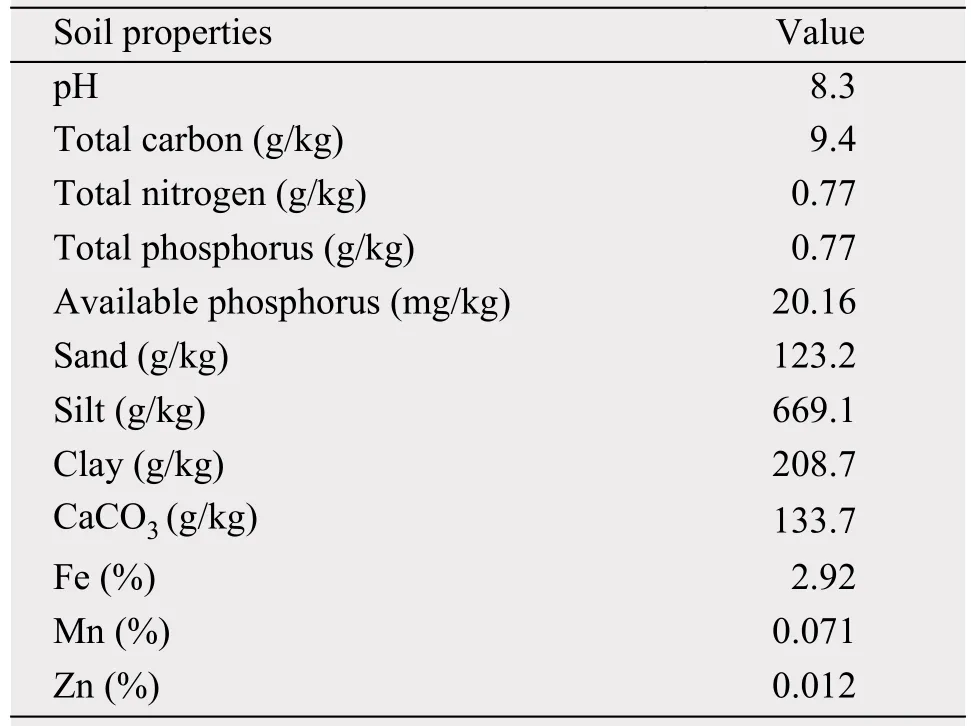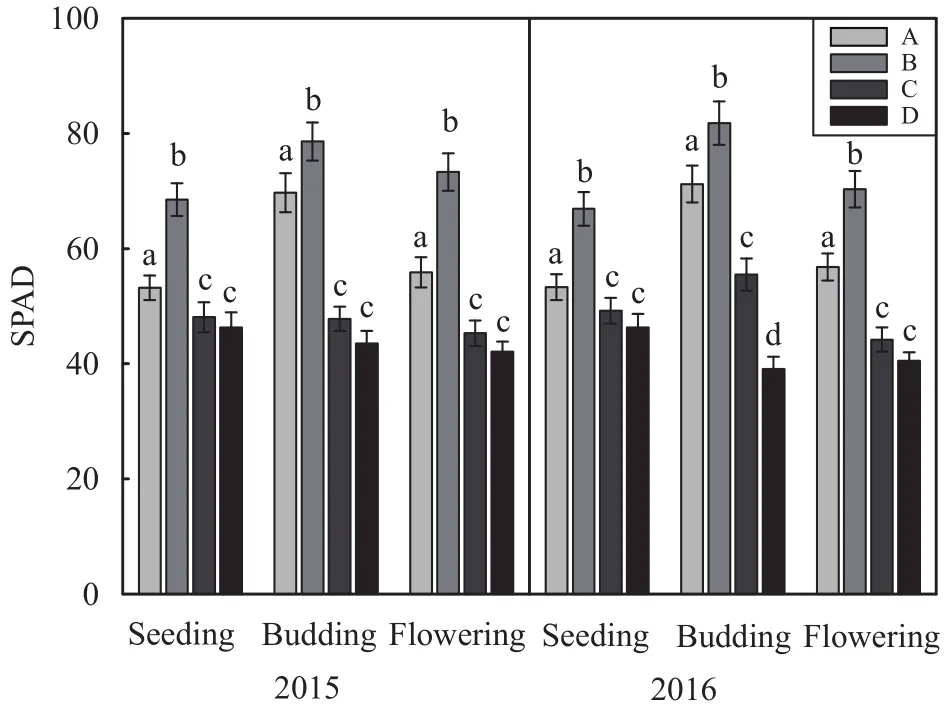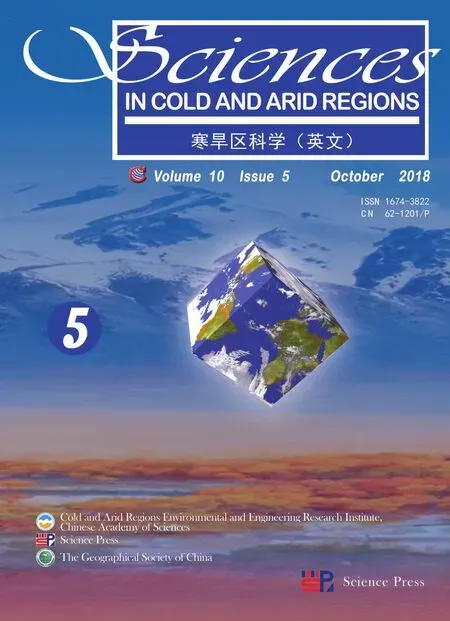Effect of slow-release iron fertilizer on iron-deficiency chlorosis, yield and quality of Lilium davidii var.unicolor in a two-year field experiment
Yang Qiu, ZhongKui Xie , XinPing Wang, YaJun Wang, YuBao Zhang,YuHui He, WenMei Li, WenCong Lv
Northwest Institute of Eco-Environment and Resources, Chinese Academy of Sciences, Lanzhou, Gansu 730000, China
ABSTRACT Iron deficiency chlorosis of Lilium davidii var. unicolor is often the case in practice in alkaline soils of northwest region of China. It is difficult to control iron chlorosis because of high cost and short effective work time of conventional iron fertilizers. In this study, a 2-year field experiment was conducted to evaluate the effects of two slow-release fertilizers on the suppression of iron deficiency chlorosis, soil chemical properties, and the yield and quality of L. davidii var. unicolor. Results show that both coated slow-release iron fertilizers and embedded slow-release iron fertilizer effectively controlled iron-deficiency chlorosis. The application of slow-release iron fertilizers significantly increased plant height and chlorophyll content of L. davidii var. unicolor at different growth stages. Furthermore, coated iron fertilizer application significantly increased starch, protein, soluble sugar and vitamin C content of L. davidii var. unicolor, and it also significantly improved total amino acid content, with increases in essential amino acids (Trp, Leu, Lys, Phe, Val, and Thr contents) and in nonessential amino acids (Asp, Glu, Cit, Ihs, Acc, Ala, Pro, and Cys contents). It was concluded that application of coated slow-release iron fertilizer could be a promising option for suppression of iron deficiency chlorosis and deserves further study.
Keywords: slow-release fertilizer; iron-deficiency chlorosis; Lilium davidii var. unicolor; long-term
1 Introduction
Lilium davidiivar.unicoloris a herbaceous, perennial, bulbous monocot in the family Liliaceae. It is a medical and edible dual-purpose plant (Liet al.,1990), highly prized in Gansu Province, China, and widely known for its sweet flavour, high quality and remarkably nutritious (Konget al., 1958). The economic benefit ofL. davidiivar.unicoloris remarkable, with more than 7 thousand hm2in cultivation in Lanzhou City alone, production of more than 30 million kilograms, and a value of more than 2 billion RMB (Liu and Fu, 1999). At present, the number of enterprises in Gansu Province engaged in the processing and sale ofL. davidiivar.unicoloris over 300, but is still short of market demand (Zhou, 2016).Thus, market prospects and economic benefits provide ample opportunity for the rapid development ofL. davidiivar.unicolor.
Lilium davidiivar.unicoloris suitable to cold climates and loose, neutral or slightly acidic soil, yet is primarily planted in Gansu and Ningxia provinces where the soil pH values are above 7.5. In alkaline soils, the effectiveness ofL. davidiivar.unicolorin absorbing iron is low, and iron deficiency is a common problem throughout the planting area. Iron deficiency inhibits the synthesis of chlorophyll, which leads to leaf yellowing, and eventually plant wilt (Jolleyet al., 1996; Broadleyet al., 2007; Christinet al.,2009). Control of iron chlorosis ofL. davidiivar.unicoloris not easy. Many control measures including tillage management, foliar sprays and adding conventional iron fertilizers to the soil have been used,however none of these measures are completely effective in preventing iron chlorosis because of high cost and short effective work time. Gooset al. (2004)reported that slow-release iron fertilizer have significant advantages in preventing iron chlorosis and deserves further evaluation in soybean production.
Therefore, slow-release iron fertilizers forL. davidiivar.unicolorare urgently required to improve the utilization ratio of fertilizers, control iron chlorosis and increase production. The coated slow-release iron fertilizer and the embedded slow-release iron fertilizer were used in a 2-year field experiment, which was conducted to investigate the effects of these two fertilizers onL. davidiivar.unicolor, in addition to soil chemical properties and the growth status of the plant. The objectives were to (1) determine the effect of the slow-release fertilizers on soil chemical properties, height and chlorophyll content of the plant; (2)evaluate the effect of slow-release fertilizers on the control of iron chlorosis; and (3) determine the effects of the slow-release fertilizers on yield and quality ofL. davidiivar.unicolor.
2 Materials and methods
2.1 Site description and sampling
A 2-year field experiment was designed and conducted from February 2015 to November 2016 at the Gaolan Research Station of Ecology and Agriculture,Northwest Institute of Eco-Environment and Resources, Chinese Academy of Sciences. The station is located in the northwestern area of the Loess Plateau(Lanzhou City, Gaolan County, Gansu Province,China; 36°13'N, 103°47'E) at an altitude of approximately 1,800 m. Based on 30-year records, mean annual rainfall is 263 mm of which nearly 70% occurs between June and September. The mean annual temperature of the region is 8.4 °C, with monthly mean temperature reaching a maximum of 20.7 °C in July and a minimum of -9.1 °C in January. The soil is a silt loam of loess origin and belongs to the Haplic Orthic Aridisols. Initial soil characteristics were tested before basal fertilizer application to a depth of 40 cm,and the results are presented in Table 1.

Table 1 Initial soil properties of the 0–40 cm soil layer of the experimental site
Four treatments consisting of embedded slow-release iron fertilizer (A), coated slow-release iron fertilizer (B), untreated FeEDDHA (C) and a control without iron fertilizer (D) were examined with three replicates per treatment, with each replicate in a 4m×4m plot. All the plots were randomly distributed.Fertilizer A, with a pH of 6.5, contained 15%FeEDDHA, which was embedded in an acid-modified attapulgite and granulated. Fertilizer B was fertilizer A coated with synthetic resin.
The bulbs ofLilium davidiivar.unicolorused in the study were robust and not split, and were collected locally in Lanzhou, with an average weight of 21 g. The bulbs were furrow planted at a depth of 5 cm with an in-row spacing of 0.15 m that was 0.25 m apart in March 2015. Each year, before the emergence of seedlings in April, all treatments received 150 kg·N/hm2, 750 kg organic fertilizer per hm2and 150 kg FeEDDHA per hm2.
Irrigation was not used in this study. Soil samples were collected in September 2016 at the end of the cultivation season. Each sample was a bulked surface soil sample obtained from ten subsamples that were randomly collected in each plot to a depth of 40 cm.Soil samples were sieved through a 2-mm mesh before analysis. Plant height was recorded and 200 leaves were randomly selected to determine the chlorophyll content at the seeding (April 15), budding (May 30) and flowering (July 15) stage in each year. Yield and quality were determined in November 2016.
2.2 Soil analyses
The soil pH was determined according to ISO 10390 (ISO, 1994). Total organic carbon (TOC) was determined by potassium dichromate (K2Cr2O7) oxidation at 170 °C to 180 °C, followed by titration with 0.1 mol/L ferrous sulphate (Walkley and Black,1934). Total nitrogen (TN) was measured using the Kjeldahl digestion method and total phosphorus (TP)was extracted in aqua regia following ISO 11466(ISO, 1995). Available phosphorus (AP) was measured using the method of NY/T1121.7-2006 and trace elements were analysed following the procedures in AFNOR (2004). Fe content was measured using the method of GB 7873-1987 and available iron was measured using the method of LY/T1262-1999.
2.3 Plant analyses
Chlorophyll content of leaves was measured using a SPAD-502 chlorophyll meter (Konica Minolta Sensing, Inc. Japan.) and starch content was measured using the acid hydrolysis method according to GB/T5009.9-2003. Fibre content was determined according to GB/T 5009.88-2008 and soluble sugar content was measured using the Fehling method according to GB 6194-1986. Reducing sugar content was measured according to GB/T 5009.7-2003 and vitamin C (ascorbic acid) content was measured according to GB 5009.86-2016. Amino acids content was measured according to GB/T 5009.124-2003.
2.4 Data analyses
Data were subjected to analysis of variance (ANOVA), and when the results were significant, means were compared using Fisher's least-significant-difference test with significance atp<0.05 (LSD0.05).
3 Results and dicussion
3.1 Soil physicochemical properties
The effects of slow-release iron fertilizers on the physicochemical parameters of soils are summarized in Table 2. No significant difference in pH, TC, TN and TP was detected among the treatments. The AP content did not differ significantly among the B, C and D treatments, but the AP content in A treatment was significantly higher than that in other treatments.The difference in Fe content among four treatments was not significant. Table 3 show the changes of available iron in soils at three stages of growth in different treatments.

Table 2 Selected soil chemical properties from different treatments in 2016 after harvest

Table 3 Changes of efficient iron in soils at several stages of growth
The available iron content in C treatment was highest at seeding stage, however, the available iron content in A and B treatments was significantly higher at budding and flowering stages than that in the other treatments and the available iron content in A treatment was highest. These increases in available iron content in A and B treatments could be due to slow-release iron fertilizers providing a lasting supply of trace elements (Zhuet al., 2013). Both of the coating and embedding iron fertilizers can reduce the leaching loss and oxidation loss to some extent. The highest iron content in A treatment at budding and flowering stages show the coated iron fertilizer delayed release of available iron.
3.2 Plant height and chlorophyll content
As presented in Figure 1, with the growth of the plant, plant height ofLilium davidiivar.unicolorincreased gradually and reached the maximum in the flowering stage during the experiment. For the different treatments, the plant height in the two slow-re-lease iron fertilizer treatments (A and B) was significantly higher than that in C and D treatments. The plant height in the B treatment was the highest in each growth stage. The plant height in the C treatment was significantly higher than that in the D treatment in the seedling stage, but the difference between plant heights in C and D treatments was not significant.This result might be due to the reduced availability of certain essential micronutrients to plants in the alkaline soil (Öbornet al., 1995). The available iron in the soil of C treatment could not meet the requirements ofL. davidiivar.unicolorin the budding and flowering stages with the rapid decline of iron fertility in the alkaline soil.

Figure 1 Changes in plant height of Lilium davidii var.unicolor in various treatments at three stages of growth.Values of a parameter followed by a different letter indicate a significant difference between treatments (p <0.05)
The changes in chlorophyll content ofL. davidiivar.unicolorin different treatments at different stages of growth are presented in Figure 2. The chlorophyll content increased gradually and reached the maximum in the budding stage and then decreased significantly to reach the minimum in the flowering stage during the two-year experiment. The maximum of chlorophyll content was in the B treatment at each growth stage, following with the second highest chlorophyll content in the A treatment, which were significantly higher than that in C and D treatments.The chlorophyll content in C treatment was significantly higher than that in the D treatment in the budding stage in 2016, but the difference between the chlorophyll contents in C and D treatments was not significant in the other growth stages during the experiment. The increase in chlorophyll content in the two slow-release iron fertilizers treatments (A and B)was also an indication that the slow-release fertilizers could reduce the rate of iron chlorosis (Table 4),which might be due to increased supply of available iron from the slow-release iron fertilizers to meet the requirements of the different growth stages ofL. davidiivar.unicolor.

Figure 2 Changes in chlorophyll content of Lilium davidii var. unicolor in various treatments at three stages of growth.Values of a parameter followed by a different letter indicatea significant difference between treatments (p <0.05)

Table 4 Effect of different treatments on iron-deficiency chlorosis at the flowering stage
3.3 Yields
The yields ofLilium davidiivar.unicolorin different treatments after two years of growth are presented in Table 5. All the yields in different treatments were significantly higher than seed-planting (4,521.68 kg/hm2),and the growth rate in the two years of the experiment varied from 78.53% to 129.83%. Yields were highest in B treatment (by 28.73%, compared with the control), followed by yields in A treatment (by 15.36%, compared with the control) and C treatment(by 5.51%, compared with the control). These results indicated that these slow-release iron fertilizers significantly increased yields ofL. davidiivar.unicolor,with even the yields in C treatment significantly higher than those in the control. The increase in yields in the fertilizer treatments might be the result of more robust growth of the belowground parts ofL. davidiivar.unicolor, which increased the accumulation of underground bulb matter, thereby increasing the yield.

Table 5 Yields of Lilium davidii var. unicolor in different treatments after two years of growth
3.4 Quality
The quality ofLilium davidiivar.unicolorfrom different treatments is presented in Table 6. The starch content in A and B treatments were significantly higher than that in C and D treatments. A previous study shows that edibility was positively correlated with starch content (Liuet al., 2014); thus, for edibility, A and B treatments would be better than other treatments. The cellulose content was not significantly different among the treatments. The protein content is an important indicator of quality (Wanget al., 2015).The protein content in B treatment was the highest,with that in A treatment the second highest, and the difference in protein content between C and D treatments was not significant. This result is consistent with that of Tianet al. (2014) who reported that trace element fertilizer increases the protein content of alfalfa.

Table 6 Nutrient quality of Lilium davidii var. unicolor from different treatments
The soluble sugar content in B treatment was significantly higher than that in the other treatments, and the lowest soluble sugar content appeared in D treatment. Yanget al. (2016) reported that soluble sugar content was positively correlated with taste, and therefore, the result suggested that the coated iron fertilizer could improve the taste ofL. davidiivar.unicolor.The difference in reducing sugar content among all treatments was not significant. The Vc content in treatment B was significantly higher than that in the other treatments, and the difference in Vc content among B, C and D treatments was not significant.Vitamin C has an antioxidant effect (Yuet al., 2008),and from this perspective, the coated iron fertilizer improved the healthcare value ofL. davidiivar.unicolor.
Total and individual amino acid contents have important influences on taste and nutritional value and therefore were important indicators of the quality ofLilium davidiivar.unicolor. As presented in Table 7,contents of both total essential amino acids and total nonessential amino acids in A and B treatments were significantly higher than those in the other treatments,and the total amino acid content in B treatment was the highest among all the treatments. Compared with the control, the contents of essential amino acids (Trp,Lys, and Thr) and nonessential amino acids (Asp,Glu, Cit, ihs, Can, and Acc) increased significantly in A treatment. Additionally, the contents of Trp, Leu,Lys, Phe, Val, and Thr (essential amino acids) and those of Asp, Glu, Cit, ihs, Acc, Ala, Pro, and Cys(nonessential amino acids) increased significantly in B treatment compared with the control.
4 Conclusions
Results of the present study demonstrated that the application of slow-release iron fertilizers effectively controlled iron-deficiency chlorosis and increased the yield and quality ofLilium davidiivar.unicolor. The coated, slow-release trace element fertilizer increased plant height and chlorophyll content of leaves, and eventually led to a significant increase in yield and quality, as measured by contents of starch, protein,soluble sugars and Vitamin C and several amino acids. Further studies should be conducted to better understand the consequences of these slow-release iron fertilizers for changes in iron content and microbial community in the soil and how these effects can lead to changes in suppression of iron-deficiency chlorosis and agricultural productivity.

Table 7 Effect of different treatments on amino acids
Acknowledgments:
This research was supported by China's National Natural Science Foundation (No. 41501043), by the"West Light" project of the Chinese Academy of Sciences, and by the project of 60th Chinese postdoctorate science fund (No. 2016M602904). We are grateful to anonymous reviewers for their constructive comments on the manuscript.
 Sciences in Cold and Arid Regions2018年5期
Sciences in Cold and Arid Regions2018年5期
- Sciences in Cold and Arid Regions的其它文章
- Study of thermal properties of supraglacial debris and degree-day factors on Lirung Glacier, Nepal
- Comparison of temperature extremes between Zhongshan Station and Great Wall Station in Antarctica
- Numerical simulation of the climate effect of high-altitude lakes on the Tibetan Plateau
- Comparison of precipitation products to observations in Tibet during the rainy season
- Altitude pattern of carbon stocks in desert grasslands of an arid land region
- Comparison of two classification methods to identify grain size fractions of aeolian sediment
